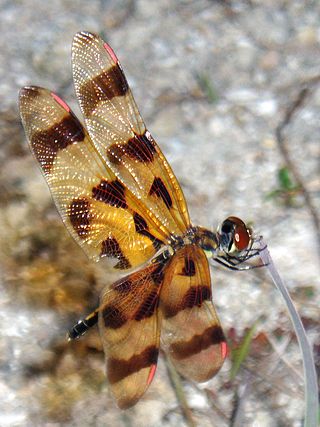
Odonata is an order of predatory flying insects that includes the dragonflies and damselflies. The two groups are distinguished with dragonflies usually being bulkier with large compound eyes together and wings spread up or out at rest, while damselflies are usually more slender with eyes placed apart and wings folded together along body at rest. Adult odonates can land and perch, but rarely walk.

Celithemis is a genus of dragonflies in the family Libellulidae. They are known commonly as pennants. There are eight species in this monophyletic genus. They are mainly distributed in eastern North America.

Allocnemis, formerly Chlorocnemis, is a genus of damselflies in the family Platycnemididae.

Boninthemis is a monotypic genus of dragonflies in the family Libellulidae containing the single species Boninthemis insularis. It is endemic to Japan.

Ceriagrion is a genus of damselfly in the family Coenagrionidae. Species of Ceriagrion are small to medium size, generally brightly coloured damselflies. They are found across the Old World, Africa, Asia and Australia.

Chlorocypha is a genus of damselflies in the family Chlorocyphidae.
Diastatomma is a genus of dragonfly in the family Gomphidae. It contains the following species:
Idomacromia is a genus of dragonflies in the family Synthemistidae, which is earlier treated as a subfamily of Corduliidae. According to World Odonata List, this genera is best considered incertae sedis.
Isomma is a genus of dragonflies in the family Gomphidae. It is endemic to Madagascar and contains only two species:

Lestes is a genus of damselfly in the family Lestidae. The family hold their wings at about 45 degrees to the body when resting. This distinguishes them from most other species of damselflies which hold the wings along, and parallel to, the body when at rest.

Onychogomphus is a genus of dragonflies in the family Gomphidae. They are commonly known as pincertails.

Paragomphus is a genus of dragonfly in the family Gomphidae. They are commonly known as hooktails.

Phyllomacromia a large genus of dragonflies in the family Macromiidae. They are commonly known as cruisers.

Tetrathemis is a genus of dragonflies in the family Libellulidae. Species of Tetrathemis are found in Africa, Madagascar, Asia, New Guinea and Australia.

Zygonyx is a genus of dragonflies in the family Libellulidae. They are commonly known as cascaders because of their preference for living beside waterfalls and flying through the spray. They lay their eggs in wet dangling roots.

Euphaeidae, sometimes incorrectly named Epallagidae and commonly called gossamerwings, is a family of damselflies in the odonate superfamily Calopterygoidea. The family is small, consisting of around 78 species living species in nine genera occurring in the Palearctic, Australasia, and Asia. The family contains two subfamilies, Euphaeinae, encompassing all the living species and a single fossil genus, and the extinct Eodichromatinae, encompassing fossil genera from the Eocene to late Oligocene. Euphaeid species are large and mostly metallic-coloured, looking similar to species of damselflies in the family Calopterygidae.

The Synthemistidae are the family of dragonflies commonly known as tigertails, or sometimes called southern emeralds. This family is sometimes treated as a subfamily of Corduliidae. This is an ancient dragonfly family, with some species occurring in Australia and New Guinea. Most species are small in size and have narrow abdomens. Their nymphs are bottom dwellers, and resist droughts by burying themselves very deeply. Synthemistid dragonflies frequently prefer marshy areas, as well as fast-flowing streams. The family Synthemistidae is sometimes called Synthemidae.

Chalcolestes viridis, formerly Lestes viridis, is a damselfly of the family Lestidae. It has a metallic green body and at rest it holds its wings away from its body. Its common name is the willow emerald damselfly, the green emerald damselfly, or the western willow spreadwing. It has an elongated abdomen and pale brown spots on its wings and resides in areas of still water with overhanging trees.

The brilliant emerald, Somatochlora metallica, is a middle-sized species of dragonfly. It is the largest and greenest of the Somatochlora species; 50–55 millimetres (2.0–2.2 in) long.















